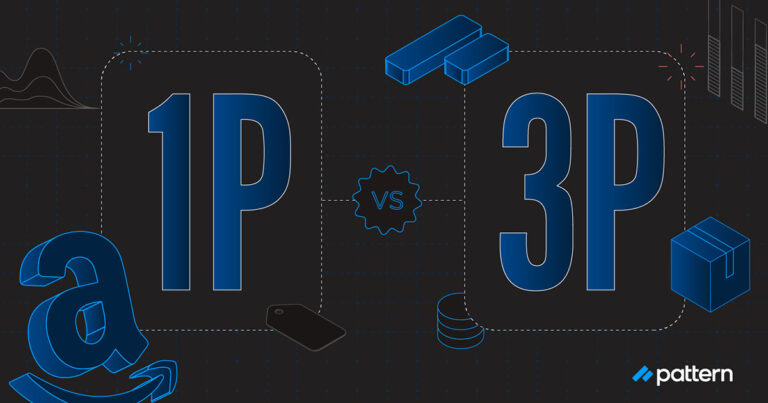As an Amazon seller, whether you’ve participated in Prime Day in the past or you’re considering it for the first time, you’re probably very aware of the massive marketplace event. With omnichannel advertising campaigns promoting unprecedented deals and limited availability, Amazon creates a sense of urgency to buy now.
The data shows the event has experienced steady and substantial growth over time. In 2022, Prime Day sales grew to $12 billion, with consumers purchasing more than 300 million items worldwide. By contrast, Cyber Monday sales for the same year reached just $11.3 billion, making Amazon Prime Day the biggest ecommerce sales events in the United States. Because of its past performance, we fully expect Prime Day 2023, July 11-12, to produce even greater sales.
Prime Day Boosts the Ecommerce Equation
At Pattern, we’ve developed a data-driven revenue model for brands: traffic x conversions x price x availability = revenue. Our teams implement this model time and time again to improve brands’ performance on marketplaces like Amazon. When every aspect of the equation is optimized, your products are positioned to grow their profitability.
Pattern’s efforts for brands on Prime Day focus on optimizing traffic because as you increase the traffic to your listings, you generate greater revenue.

How Does Prime Day Create New Traffic?
Simply put—everyone wants a deal, and Prime users wait all year for Prime Day exclusively for lower than normal promotional prices. So, shoppers show up in greater numbers during Prime Day. With 161.7 million Prime users in 2023, the audience and opportunity that comes with Prime Day is significant. In fact, Amazon reports a 216% increase in awareness and 214% increase in consideration for brands that advertised throughout all phases of Prime Day.
Other ecommerce retailers have taken notice, too. Amazon’s Prime Day has become so powerful in driving overall retail traffic that traditional brick and mortar shops now plan their own promotions around Prime Day, hoping to take advantage of deal-hungry customers. In addition, rival marketplaces have started launching their own version of the sales event, with Walmart creating Walmart+ Weekend, and Target creating Deal Days.
It’s evident that where there’s smoke, there’s fire and where there’s deals, there’s customers.
Why is Prime Day Traffic Important?
As more brands and marketplaces take note of the opportunities Prime Day brings, it’s important you stay competitive and strategize to take advantage of the event’s benefits, too. Below are two reasons Prime Day traffic can be a significant bonus to your brand:
1. More Advertising Bang from Amazon’s Buck
As an Amazon seller, Prime Day drives cheaper, higher-volume traffic to your advertised products than you can get at any other time. Amazon’s investment in Prime Day’s success is a win for all sellers. Amazon reports 82% of shoppers learn about new brands leading up to Prime Day, and 75% are likely to purchase a product during Prime Day they discovered during the lead-up to the event.
Amazon also reported that during Prime Day, there’s also the opportunity to increase brand loyalty with 69% of shoppers surveyed saying they were likely or highly likely to buy other products from the same brand.
Brands that choose to run deals and ads during Prime Day can be part of Amazon’s own advertising without having to spend any extra advertising dollars to get directly in front of its Prime customer base. With our fundamental knowledge of and deep relationship with Amazon, Pattern can help its brands attain these coveted spots.
In addition, brands pushing Prime-Day-exclusive deals can also show up on category deal pages and under the Prime-exclusive deal filter.
2. Gain Amazon-Exclusive Customers
Considering the large number of products available on Amazon and the benefits of free, fast shipping for Prime members, customers are increasingly turning only to Amazon to shop. In a survey of 2,000 U.S. consumers, 89% reported being more likely to buy products from Amazon than other ecommerce sites, and the number jumped to 96% for Amazon Prime members.
It’s highly unlikely that this amount of traffic would end up on your direct-to-consumer (DTC) site, so capturing visitors on Amazon may be the only way to win their business. When pushing a Prime Day promotion, you’re not taking traffic away from your website, you’re adding consumer traffic you would have otherwise missed.
Pattern Drives Traffic for Your Brand to Win on Prime Day and Beyond
As an ecommerce accelerator and one of Amazon’s top sellers, our advertising experts know how Prime Day can generate new traffic opportunities for your brand and how to take advantage of Prime Day traffic. We leverage our data-driven insights from years of experience on Amazon as well as our premier leadership position on the marketplace to put your brand ahead of the competition, on Prime Day and beyond.
Are you ready for Prime Day? Get in touch today.





